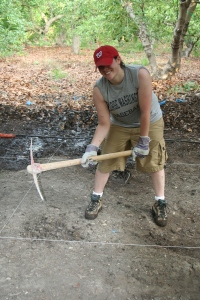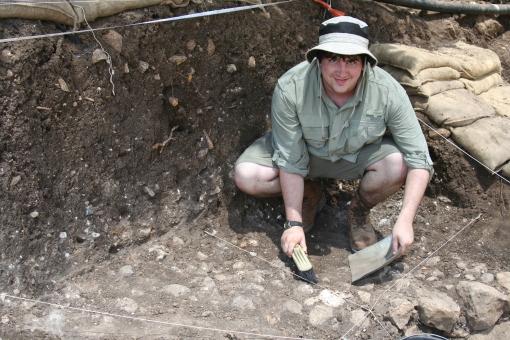Update (9 August 2009)
A brief report on the preliminary results from the 2009 excavation season is now available. Please click on the following link:
Preliminary report on the results of the 2009 excavation season at Tel Kabri
——————————————————-
Location and Accommodations
Tel Kabri is located in northern Israel, a short drive from Acco and Nahariyya; a longer drive from Haifa.
We will be staying at Kibbutz Lohame HaGetaot (the Polish Ghetto Fighters kibbutz), a ten-minute drive from the site. Rooms are air-conditioned, each with their own telephones, color televisions, and kitchenettes; each fits three-four volunteers.
The kibbutz has a swimming pool and a grocery store which we are welcome to use, as well as a dining hall in which we will eat lunch every work day. Dinner will be a catered affair, with food brought from Nahariyya or Acco each evening.
Workdays and Weekends
A typical excavation day begins in the field at 5 am and ends at 1 pm (yes, you read that correctly; this is a typical schedule for excavations in Israel, designed so that we dig during the coolest parts of the day, for the most part). After lunch and siesta/swimming pool break, work on the finds continues between 4-6 pm in the excavation camp. For those who are enrolled in the field school, several afternoons a week will be dedicated to lectures and practice of field techniques.
The excavation work-week is Sunday through Thursday, with Fridays and Saturdays free. On those “weekends,” the rooms will still be available, but both volunteers and staff will be on their own for food, since so many team-members travel on the weekends to Jerusalem, Tel Aviv, Tiberias, Haifa, Masada, and the Dead Sea.
Excavation Expectations
On Site
Team Members will be on the tel and ready to work by 5AM. Team Members report to and act under the direction of their Area Supervisor. Supervisors will allocate tasks to the Team, depending on conditions in the field. Team Members are normally assigned to excavate within a single sector or Area to enable them to follow progress over the course of their stay. Weekly tours of the areas of excavation will furnish an overview of the Project as a whole. Back in camp, Team Members are expected to assist with the proper treatment of finds, including the washing and registration of objects.
Morning Working Conditions
Activity on the tel can be taxing, but is balanced between heavy excavation and meticulous work with small tools. Assignments range from loosening soil with pickaxes or hauling buckets or wheelbarrows of dirt, to trimming the sides of baulks with trowels, sifting for small objects or sweeping the ground to prepare for photography. Afraid that you might not find anything? Have no fear — you will be bringing buckets of pottery back to camp every day!
Afternoon Working Conditions
Work in shaded areas at the base camp includes washing and recording pottery and other artifacts, computer data entry, and other light tasks.
Temperatures and Gear
Daytime temperatures range from 82-95° F. (28-35 C.). Most of the excavation areas are shaded, and a steady breeze relieves the heat on most of the tel for much of the day. It is quite humid, however, and hats, sun block, and water bottles are obligatory. Sturdy boots to protect feet and ankles are also a must. In fact we do not allow sandals to be worn during work hours.
Goals for the 2009 season
During the 2009 season, we will be excavating in Area D-West, D-North, and D-South. We will also excavate and take samples in three squares in the area of the rampart at the northern edge of the site, close to the modern cemetery.
In Area D-West, we plan to re-initiate the excavation of the core of the MB II palace primarily within Room 1433a. It was this room that, along with Room 740, Kempinski and Niemeier thought might have served as a throne room (based upon parallels with the palace at Alalakh), but it was left unexcavated by them. In addition, since we now know that the Aegean-style miniature frescoes were found only in secondary contexts at Kabri, i.e. used as filling material for the thresholds of the MB II building in its final phase, we shall attempt to excavate the threshold fillings at the entrances to Rooms 740, 1433a, and 667, all of which were renovated during the latest use of the building and are thus prime candidates for the presence of additional fragments of Aegean-style paintings.
In Area D-North, we will continue to excavate and expose the plaster floors of the MB II palace, seeking in particular to determine whether any of them were painted in an Aegean style, like Hall 611 to the west. We will also open additional squares in this area, to both the east and the west of our 2005 excavations, in order to link the excavations of Kempinski and Niemeier (lying to the west) with the rescue excavations of 2001 (lying to the east) while at the same time trying to determine the eastern-most extent of the MB II building.
In Area D-South, excavation will continue down to the floors and then below the courtyard area of the MB II palace, in order to see whether it was preceded by an earlier court or by different structures. During our 2005 excavations in this area, we also encountered the corner of an additional, and monumental, MB II construction which, according to Prof. E. Oren, is very likely a Syrian-style entrance complex related to the MB II building. We plan to further expose this complex and to determine whether it was first constructed during the period of the later MB II palace or whether it was already part of an earlier MB I structure.
College Credit
Three units of college credit will be offered through the Study Abroad Office of The George Washington University, as Anth 116 (Mediterranean Field Program), which will be offered during each three-week session. If participants have already received such credit, they can sign up for between one and three credits as Anth 195 (Independent Research Project) and work one-on-one with a faculty or staff member to determine a suitable project.
Program Costs
Please note that if participants are planning to take part in the excavations for college credit, the application procedure and payment must be made through the Study Abroad Office of The George Washington University (see link on the Application page above). Costs for such participants will be bundled into a single package, as described on the relevant webpage of the Study Abroad Office. Those not planning to participate for credit will apply directly to the Kabri Archaeological Project (with the link also found on the Application page above). However, room and board fees will be the same for all participants, regardless of whether they are participating for credit or not. Those fees are as follows:
Room and Board ($375 per week):
Session 1 (21 June – 9 July 2008): $1,125
Session 2 (12-30 July 2008): $1,125
Both Sessions (21 June – 30 July 2008): $2,250
Airfare is not included in the above costs, nor is food or individual travel on the weekends (Friday-Saturday).
All payments will be due in full by 1 March 2008. Those canceling between 2 March and 1 June will receive a half-refund, while those canceling between 2 May and 1 June will receive only a quarter-refund, and those canceling after 1 June will receive no refund at all, except under extenuating circumstances.
Application Procedures
Prospective volunteers must complete a preliminary application, which can be found by clicking the above “Application” link. For questions, please contact directly:
Eric H. Cline, Ph.D.
Chair, Department of Classical and Semitic Languages and Literatures
Associate Professor of Classics and of Anthropology (Ancient History and Archaeology)
The George Washington University, 345 Phillips Hall, 801 22nd St. NW, Washington, D.C. 20052
Tel: (202) 994-0316, Fax: (202) 994-2156; Email: ehcline@gwu.edu
Web Pages: http://home.gwu.edu/~ehcline/








Leave a comment